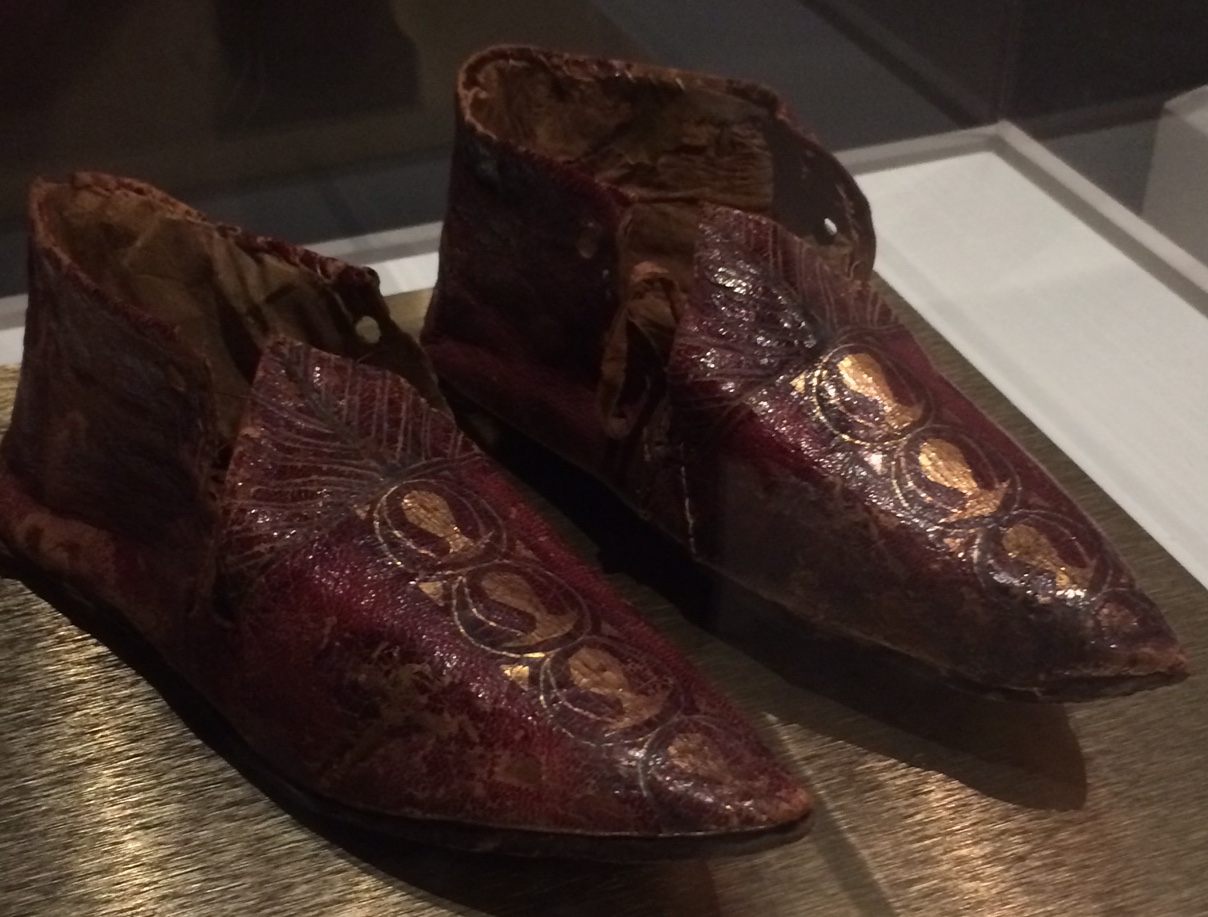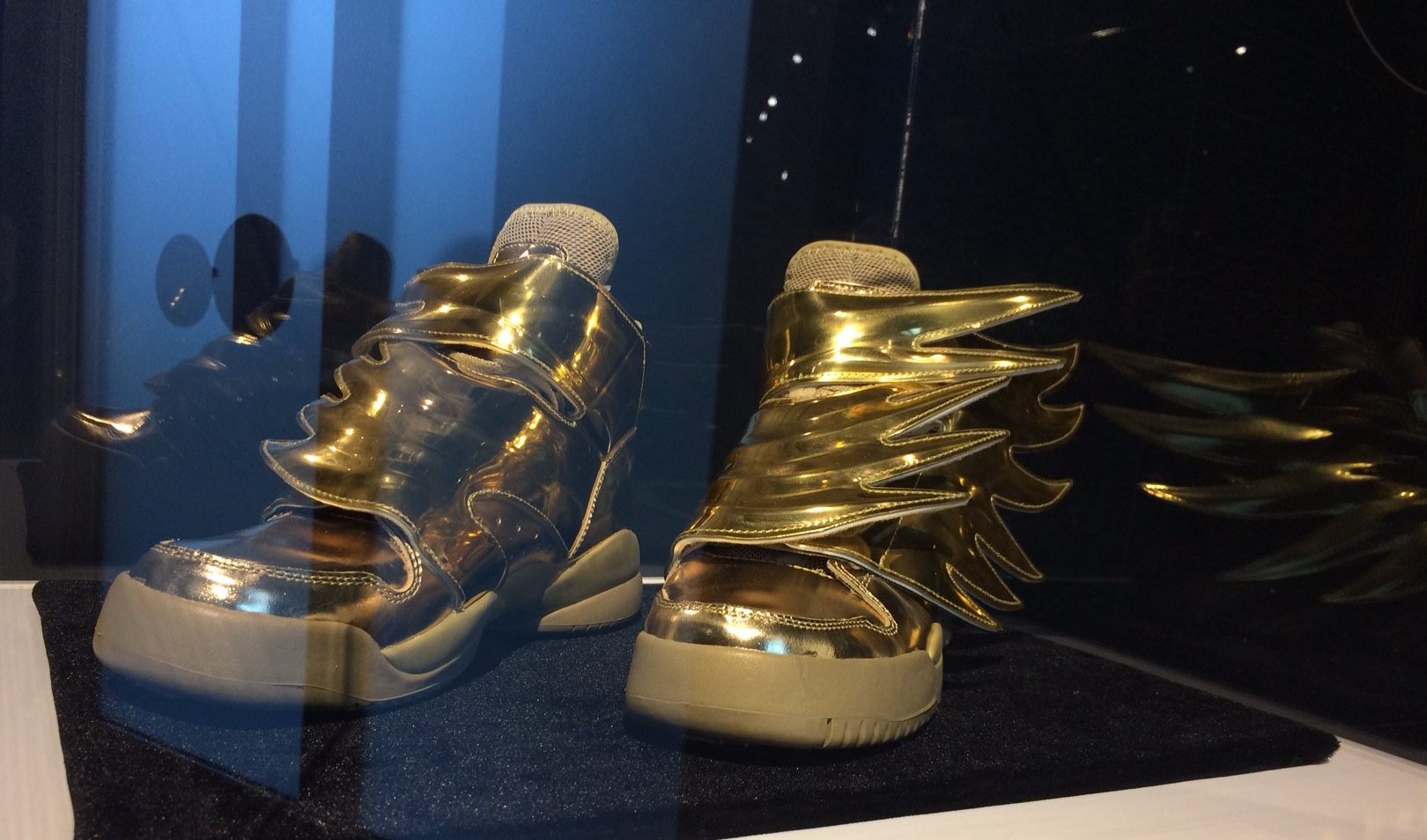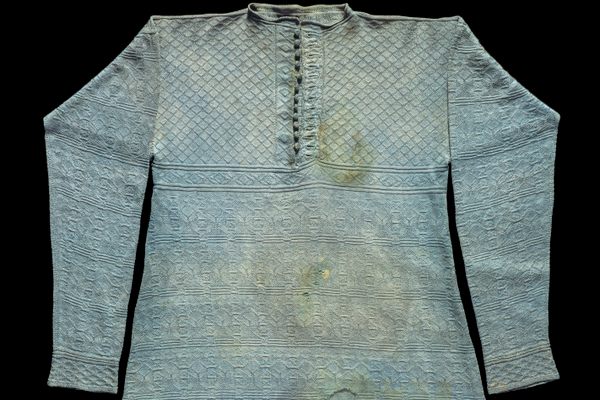Walking the Walk With a Professional Shoe Conservator
The past, present, and future of footwear, from an expert charged with keeping soles intact.

When I call Ada Hopkins to talk about shoes, I’m a little embarrassed to tell her what’s on my feet: mangled rubber soles, a synthetic leather upper groaning at the seams, a vamp crusty with salt and road grime. Hopkins suggests a quick rinse with vinegar and water. “This is not a conservation suggestion,” she says, laughing. “This is just a what-I-do-at-home suggestion.”
I trust it, because Hopkins knows her shoe stuff. For around three decades she’s worked as a conservator at Toronto’s Bata Shoe Museum, which collects and showcases footwear spanning thousands of years.
The Museum’s new show, The Gold Standard, offers gilt sandals, slippers, and strappy numbers from all over the globe. There is ecclesiastical footwear from ancient Egypt, a pair of velvet-and-lace chopines from 16th-century Italy, and, from China, intricately embroidered booties designed for bound feet. Getting such diverse materials prepped for display was a kind of conservation tour de force. Atlas Obscura spoke with Hopkins about tricky repairs, entropy, and what happens when chintzy materials have a meltdown.

How do you evaluate the items that come into the museum?
When something is initially received into the museum, it’s looked at by the curator and myself. We examine the items to see what the condition is. If we have pest issues, they tend to be moths on wool and silk. I haven’t had to deal with beetle infestations, like in wood. If [a pair has] moths, we ask for permission to freeze them.
If they’re accepted into the collection and there are loose elements, they’re put into a container so those elements stay together. Then they’re catalogued by the collections manager, and then they come back to me. I look at them and determine if they’re going to really rapidly deteriorate, or if they can sit on a shelf and wait for a better time.

Shoes that have been worn, of course, have wear and tear. What’s the prevailing opinion about how to conserve them?
Conservation is not about taking it back to what it originally looked like when it was made. It’s about stabilizing materials. For instance, I’m working on a pair of moccasins right now, and the steel beads are rusty. To prevent the rust from contaminating the deerskin to which they’re sewn, I have to remove that. It also obscures their shine. Think of the hub on the tire of your car: It gets all rusty and you can’t see that shiny metal look. [The moccasins] also have loose beads. To prevent those beads from falling off, threads are secured and loose beads are restrung and put back in place.
You can’t make the shoe look like it did when it was made, but you can certainly make it look better. On a pair of women’s 18th-century shoes, the upper part is usually made of textile and the bottom part is leather. The textile can be very beat-up. It can be torn, embellishments can be hanging off. Those things are fixable. If there are holes in the fabric, you’re dyeing a fabric (hopefully the same material) to match the fabric that’s missing. You’re placing it in behind the original fabric to cover the area of the hole. Depending on the fragility of the original fabric, you’re either stitching the new fabric in place, or using something less intrusive, like an adhesive.
The main modus operandi in conservation is that everything you do should be reversible. Let’s say you use an adhesive, and in the future, they find out it’s not as stable as originally thought. The next person that comes along needs to be able to remove that. Sometimes, if an item gets handled too much, a repair can fail. Then you want to be able to go in and replace it or reset it.

Are there examples of previous fixes that you’ve had to undo or redo?
On some of the 18th-century shoes there are repairs—but they’re not necessarily previous conservation or restoration treatments. They can be shoes that have been handed down, and someone has modified them to fit their feet, or to fit current fashion.
The area that I see it the most is in women’s 18th-century fashion shoes. Say the next person who inherits the shoe has a foot that is a little longer or a little thicker. Since the uppers are textile, I’ve seen a slit down the vamp of the shoe—not a really deep one, not down to the toe, but maybe an inch, max two inches long—opened up to create a “V,” and another piece of fabric inserted in a sympathetic color. [This was a] time period where your dress would normally cover that part of your shoe. The other alteration I’ve seen is that the backseam is opened up, and fabric is inserted there.
Those kind of alterations I would leave in place. Someone was adapting a shoe to stay with the style of the time.

Did anything require special attention for The Gold Standard?
There is a pair of red silk Chinese bound-foot boots that have gold floral embroidery on them. When those came to the museum, the embroidery had started to unravel. It looked like somebody had teased it with a comb. The person who originally did the embroidery followed a stencil, which was applied to the silk. That outline was right there on the fabric. I had to untangle all of the threads, and then follow the curvilinear pattern, in which the gold threads were laid down on top of the silk, and then stitch them back in place. I knew where to apply it, it was just a matter of straightening out the gold threads and filling them in.
The lining on a pair of men’s slippers was completely shredded. I had to find a silk of similar weight, dye it to match the color of the remaining fabric, and humidify and reshape all the existing lining, and align all the pieces that were loose, and then slide in new lining in between the original and the leather upper of the mule. You’re following the preexisting shape and using the extant color as a reference for the dyed fabric that you need to create.
The show also contains some very recent shoes, such as the Adidas x Jeremy Scott sneakers. What do you do to keep those items looking good down the line?
The best thing I can do is to give it the best environmental controls when it’s on display and when it’s being stored. When it’s on display, that includes not just temperature and humidity, but light levels, as well. Running shoes are all modern materials: all synthetics and plastics. They’re not fragile, so much, but they have a lot of inherent vice. Plastics break down over time.

What about contemporary shoes will flummox future conservators?
As we go forward, we have more and more synthetic materials coming into collections. Everything we’re getting has some sort of plastic component, or is all plastic. When I treat glass beads or textiles, there’s a long-standing history of conservation treatments for those materials. With plastics, it’s just sort of starting. Plastics are changing so much, so fast.
I don’t know if you’ve seen pictures of running shoes from the 1970s or ’80s, but the soles start to disintegrate and fall apart. The color changes, and they just sort of fracture into pieces. In the ’60s, plastics were cutting edge, and had a certain modern, space-age quality to them. You see shoes from the ’60s that were made out of acrylic, and had PVC tubing on them for straps—that stuff you see for aquarium tubing. It gets sticky and yellows over time. Some of these plastics no longer support their own weight. At the Shoe Museum, those are the things I’m starting to see.
In the ’90s, a designer named Patrick Cox created these plastic sandals, and they had heels that were about two inches high and hollow inside. In the inside of the heel, there would be an Eiffel Tower or Statue of Liberty—those are the two that we have. I don’t know what the little sculptures are made of, but there was a gel, a thick liquid—almost like a snow dome. The plastic of the heel is starting to deteriorate, so it’s starting to sweat. The plasticizer is oozing out, and sitting on the surface. Think of something gel-like for sitting on a counter for months—it’s going to collect dust. You can see the sculpture starting to disintegrate inside the heel.
Yikes! What can you do?
That’s what we call inherent vice—you can’t turn the clock back. There are some processes that you just can’t stop. One current thought is that you can freeze these shoes, but that would take an enormous space. And if you freeze them, maybe it will stop that process, but as soon as you take them out of the freezer, that process starts up again.
Do you collect all of these shoes, knowing they’re going to deteriorate? You put them in a freezer and you don’t touch them? That sort of defeats the purpose of having a collection.
Will today’s shoes, or shoes of the future, require a totally different kind of storage strategy?
I think so. I’m in the process of trying to figure out what that is. I’m talking to a lot of other people who have plastics in their collection and trying to see how they deal with it. A lot of us are struggling to find that same information.
Women’s fashion shoes from the 18th century don’t have those issues. If there’s damage on them, you can fix it, and they’re fine. They will be fine. You can put them in their proper storage environment and walk away from them.





































Follow us on Twitter to get the latest on the world's hidden wonders.
Like us on Facebook to get the latest on the world's hidden wonders.
Follow us on Twitter Like us on Facebook